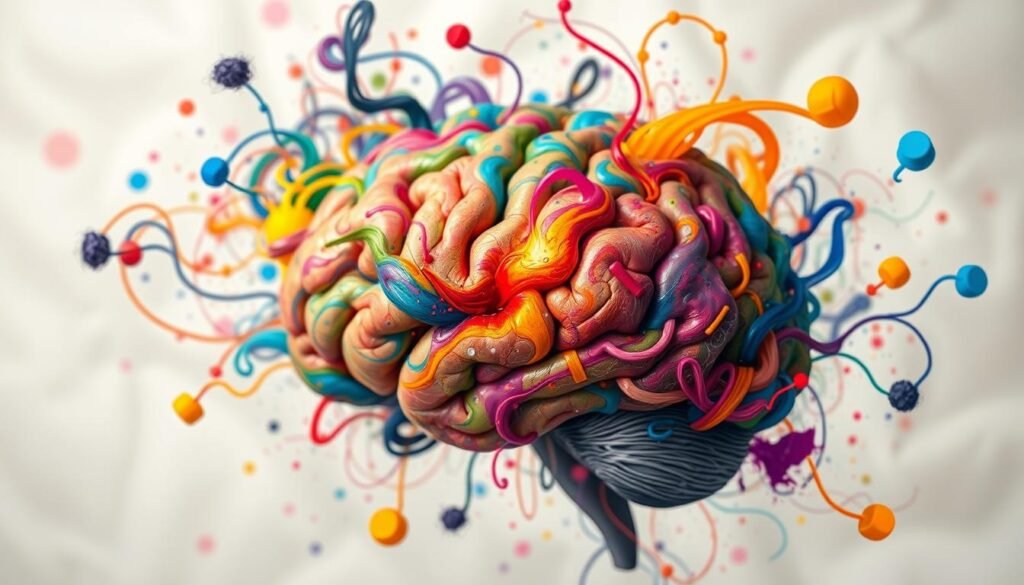For too long, ADHD talk has focused on hyperactive boys. But what about adults who’ve struggled with it their whole lives? Now, more people are recognizing adult ADHD, leading to a big change in how we support those with it.
A relative was diagnosed with ADHD as an adult, and it’s been tough. ADHD in adults shows up differently than in kids, often leading to missed diagnoses. But, thanks to more awareness and research, things are changing.
1 in 10 men with ADHD might think about suicide, and for women, it’s 1 in 4. These numbers show we need better support for adults with ADHD. By understanding and valuing neurodiversity, we can fight the stigma around ADHD.
In this article, we’ll look at adult ADHD, from its biology to how to cope. We’ll also talk about why getting a diagnosis and finding ADHD community support are key. By shining a light on adult ADHD, we can help those who’ve been silent and create a more accepting world.
Key Takeaways
- ADHD affects individuals throughout their lifespan, not just hyperactive boys
- Adult ADHD often goes undiagnosed or misdiagnosed due to differing symptoms
- Increased awareness and research are leading to a revolution in understanding adult ADHD
- Embracing neurodiversity and recognizing unique strengths can break down stigmas
- Seeking formal diagnosis and finding community support are crucial for thriving with ADHD
The Misconceptions Surrounding Adult ADHD
Many people still don’t understand adult ADHD, leading to late diagnoses. One big myth is that ADHD only affects hyperactive boys. But the truth is much more complex.
Girls with ADHD often go unnoticed, just like boys. Women and minorities are also often missed in ADHD diagnoses. This shows we need to learn more about how ADHD affects everyone differently.
ADHD Is Not Limited to Hyperactive Boys
ADHD in adults can show up in many ways, not just in kids. Symptoms like inattention and emotional issues are common. These signs can be hard to spot, making diagnosis and understanding tricky.
“ADHD is a condition acquired at birth, not through behavior or upbringing.”
Helping someone with ADHD means understanding their struggles. It’s about empathy, not just fixing their actions. By seeing how ADHD can affect people differently, we can fight stigma and support those who need it.
ADHD Is More Than Just Attention Deficits
ADHD affects many parts of life, like organization and relationships. But people with ADHD can also shine in areas they love. They can show amazing skills when they’re doing something they’re passionate about.
| Trait | Benefit |
|---|---|
| Hyperfocus | Excelling in tasks that align with interests |
| Creativity | Generating unique ideas and solutions |
| Problem-solving skills | Tackling difficult and new challenges |
Penn Holderness, diagnosed with ADHD, sees it as a superpower. He and his wife, Kim, won $1 million on CBS. They credit Penn’s ADHD for their success, highlighting its benefits.
By celebrating the strengths of those with ADHD, we can help them succeed. We can overcome the challenges of this misunderstood condition together.
Understanding the Neurobiology of ADHD
Our understanding of ADHD has grown a lot. We now know more about its neurobiology. ADHD affects 5-10% of people worldwide. It’s highly heritable, with genetics playing a big role.
Dopamine is key in ADHD neurobiology. It helps with attention, motivation, and seeking rewards.
Dopamine Deficiency: The Root of ADHD
People with ADHD often have less dopamine in their brains. This affects areas like executive functioning and impulse control. It makes it hard to focus, control impulses, and stay motivated.
Genetic factors, like the DRD4-7R allele, increase ADHD risk. The risk varies from 0 to 60% in different places.
Navigating Inattention and Hyperfocus
ADHD is known for its paradox: inattention and hyperfocus. People with ADHD can’t focus on boring tasks but get deeply into interesting ones. This hyperfocus can be both good and bad.
It helps with creativity but makes switching tasks hard. Inattention is linked to lower IQ and more developmental issues.
The Three Recognized Types of ADHD
ADHD comes in three types: inattentive, hyperactive-impulsive, and combined. Boys are more likely to have the hyperactive-impulsive type. Girls rarely show just hyperactivity and impulsivity.
Inattentive ADHD is often missed in girls and women. This leads to delayed support.
Knowing ADHD’s neurobiology is key to better treatments. Medication helps but isn’t for everyone. Therapy, skills, and accommodations are also crucial.
By understanding ADHD’s brain chemistry, genetics, and environment, we can help more people. This approach is more nuanced and compassionate.
The Bright Side of ADHD: Embracing Neurodiversity
Exploring adult ADHD reveals unique strengths and abilities. ADHD presents challenges but also brings positives to celebrate and nurture.
Did you know about 50% of individuals with ADHD are not diagnosed until adulthood? Many adults find out they have ADHD after childhood evaluations. This discovery can lead to a new understanding of their thinking and processing.
In product management, ADHD is common among successful professionals. The ability to focus intensely on problem-solving shows ADHD’s concentration power. ADHD brains are great at making connections, boosting creativity and innovation.
| ADHD Strength | Benefit in Product Management |
|---|---|
| Hyperfocus | Deep concentration on problem-solving and strategy development |
| Connecting ideas | Linking concepts from different domains, fostering creativity |
| Adaptability | Pivoting quickly in fast-paced environments |
| Empathy | Thinking from multiple angles and understanding diverse user needs |
Quickly adapting to fast-paced environments is a key ADHD strength. ADHD minds naturally jump between ideas, showing empathy and understanding diverse users. These traits are crucial in product management, where knowing user needs and adapting to market changes are key.
“Harnessing ADHD as a superpower is a game-changer in product management careers, driving innovation and user focus.”
ADHD brings energy, passion, and teamwork skills. Embracing neurodiversity and recognizing ADHD strengths makes workplaces more inclusive and innovative. It’s time to celebrate ADHD’s bright side, unlocking potential in fields like product management.
Co-Existing Conditions and Challenges
Living with ADHD can be tough, as it often comes with other mental health issues. Many people with ADHD deal with anxiety, depression, and low self-esteem. It’s key to know that these issues are common and getting help for both ADHD and these conditions is vital for well-being.

Studies show that half to two-thirds of kids with ADHD no longer meet the full criteria by young adulthood. But, this doesn’t mean ADHD goes away. It might be harder to spot in adults because of changes in how we diagnose it and the work environments people choose.
Anxiety, Depression, and Low Self-Esteem
Anxiety and depression often go with ADHD. The daily struggles and managing ADHD symptoms can hurt one’s mental health. Feeling like you’re not good enough, despite trying hard, is common.
It’s crucial to remember these feelings are real and seeking help is brave. Therapy, medication, and support groups can help manage these issues along with ADHD.
Autism, Dyslexia, and Other Neurodevelopmental Conditions
ADHD often overlaps with conditions like autism and dyslexia. This shows the need for thorough assessments that look at all aspects of a person’s abilities and challenges. Understanding how these conditions interact helps create support plans that meet each person’s unique needs.
“Disruptive disorders,” including ADHD and ODD, are prevalent mental health issues among children and teenagers.
Psychologist Russell Barkley found that ADHD and ODD share a common trait: problems with following rules. Recognizing how ADHD and other conditions interact helps us build a more supportive society for everyone.
Exploring the Possibility of Adult ADHD
Struggling with focus, organization, and impulsivity? You might wonder if you have adult ADHD. About 2% to 5% of adults have ADHD symptoms. Online screening tools and questionnaires can help you explore this.
These online tests check your symptoms and offer insights into ADHD. They ask about your attention, impulsivity, and task organization. They’re not a final diagnosis but a helpful start.
Remember, online tools aren’t a full substitute for a professional evaluation. If you think you might have ADHD, get a full assessment. This is key for an accurate diagnosis and treatment.
Gender Differences in ADHD Presentation
When looking into adult ADHD, gender differences are important. ADHD shows up differently in men and women. Women often have more inattentive symptoms.
| Gender | Common ADHD Presentation |
|---|---|
| Men | More likely to display hyperactive and impulsive symptoms |
| Women | More likely to exhibit inattentive symptoms, such as difficulty focusing and organizing |
These differences can lead to missed or wrong diagnoses in women. Healthcare professionals need to know these differences for accurate assessments.
“ADHD is not a one-size-fits-all disorder. It can present differently in different people, and it’s important to understand these variations to ensure accurate diagnosis and effective treatment.”
If you think you might have adult ADHD, explore online tools and get a formal assessment. With the right help, you can manage your symptoms and succeed in life.
The Importance of Seeking a Formal Diagnosis
If you think you might have adult ADHD, getting a formal adhd diagnosis is key. Online tests and questionnaires can give clues, but they can’t replace a detailed adult adhd assessment by a pro.
Getting a formal diagnosis can change your life. It helps you understand your problems and find the right support and adhd treatment. Many people feel relieved and validated when they get a diagnosis. It shows their challenges are real, not because of personal failings.
Knowledge Is Power: Understanding Your Struggles
With a formal adhd diagnosis, you can make sense of your past and present. You might see that your struggles, like trouble focusing or being impulsive, are because of ADHD. This knowledge lets you find ways to manage your symptoms and live better.
“Getting diagnosed with ADHD as an adult was a game-changer for me. It helped me understand why I struggled in certain areas and gave me the tools to advocate for myself and seek the support I needed.” – Sarah, 35
Accessing Appropriate Support and Treatment
A formal adhd diagnosis opens up many support and adhd treatment options. You might need:
- Accommodations at work or school
- Cognitive-behavioural therapy (CBT) to learn coping skills
- Medication to help with symptoms and focus
- Coaching to get better at organizing and managing time
| Treatment Option | Benefits |
|---|---|
| Accommodations | Helps level the playing field in work or school settings |
| Cognitive-Behavioral Therapy | Develops coping strategies and improves self-esteem |
| Medication | Manages symptoms and improves focus and concentration |
| Coaching | Improves organization, time management, and goal-setting skills |
It’s important to work with a professional who knows a lot about adult ADHD. They can help find the best treatment for you. With the right help, you can use your strengths, overcome challenges, and do well with adult ADHD.
Navigating the Assessment Process
Starting an ADHD assessment can feel overwhelming, but it’s key to understanding your challenges. It involves looking at your history, symptoms, and daily life. A professional uses interviews, questionnaires, and tests to spot ADHD and rule out other conditions.
I was diagnosed with ADHD in my late twenties. Back then, schools didn’t understand ADHD well. This made it hard to get help and choose a career. But after a detailed assessment, I understood my lifelong struggles better.
The assessment might take time, but it’s vital for a tailored treatment plan. Studies show ADHD has a strong genetic link, with 70-80% heritability. Knowing this helps us use our strengths and find ways to cope.
My journey with ADHD taught me to never give up. I’ve tried different medications and used technology to help. At 47, I see my ADHD as a strength that has made me resilient and creative in business.
If you think you might have ADHD, start the assessment process. A diagnosis opens doors to the right support and treatment. Remember, learning about yourself can change your life for the better.
Hidden in Plain Sight: The Adult ADHD Revolution
More people are now aware of adult ADHD and its signs. This awareness is changing how we view and handle ADHD in adults.

Yet, stigmas and misconceptions about adult ADHD still exist. Many think ADHD only affects hyperactive boys. But, the truth is more complex. Girls and women with ADHD often go unnoticed because they don’t fit the typical image.
Research shows that many girls with ADHD are not diagnosed or treated as kids. This is because they don’t match the common ADHD profile.
The Growing Recognition of Adult ADHD
The movement to understand adult ADHD is growing. This is thanks to new research and people sharing their stories. Books like “Driven to Distraction” and “Taking Charge of ADHD” help people understand and manage ADHD.
| Book Title | Author(s) | Key Takeaway |
|---|---|---|
| “Taking Charge of ADHD” | Russell A. Barkley, Ph.D. | The #1 pick for parents raising a child with ADHD |
| “Driven to Distraction” | Edward M. Hallowell, M.D. and John J. Ratey, M.D. | The definitive ADHD reference book since 1994 |
| “The Mindfulness Prescription for Adult ADHD” | Lidia Zylowska, M.D. | An 8-step mindfulness program for managing adult ADHD symptoms |
Breaking Down Stigmas and Misconceptions
As more people talk openly about adult ADHD, the stigma is fading. Online groups and support programs, like Focus Revolution, help people feel connected.
Participants have expressed that finding help for ADHD can be challenging and exhausting.
By sharing our stories and supporting each other, we can keep fighting misconceptions. We work towards better understanding and resources for adults with ADHD.
Finding Support and Community
Adult ADHD can be tough to handle alone. But, you don’t have to face it by yourself. Connecting with others who get what you’re going through is key. A strong adhd community can offer you support, encouragement, and tips to manage your ADHD.
The Value of Peer Support Groups
Being part of an adhd support group can change your life. These groups are safe places to share your journey, celebrate wins, and learn from others. You can find groups in person, online, or on social media.
Being in adhd support groups has many benefits:
- Feeling understood and validated by others who “get it”
- Learning practical coping strategies and life hacks from experienced members
- Gaining a sense of belonging and reducing feelings of isolation
- Receiving encouragement and accountability for pursuing your goals
- Developing lasting friendships with like-minded individuals
Finding my local ADHD support group was a turning point in my journey. I felt seen and understood, and I realized I wasn’t alone. The connections I’ve made have been invaluable.
Online Resources and Organizations
There are also many online adhd resources to help you. These offer information, tools, and ways to connect with others.
| Organization | Resource |
|---|---|
| CHADD (Children and Adults with Attention-Deficit/Hyperactivity Disorder) | Comprehensive information, support groups, and advocacy |
| ADDitude Magazine | Articles, webinars, and online community forums |
| ADHD Coaches Organization (ACO) | Directory of certified ADHD coaches and resources |
| How to ADHD (YouTube Channel) | Engaging videos on ADHD tips, strategies, and lived experiences |
Remember, you are not alone in this journey. Using the support and resources in the adhd community can help you thrive. Start today by reaching out and connecting with others who understand.
Strategies for Thriving with Adult ADHD
Living with adult ADHD can be tough, but it shouldn’t stop you from reaching your goals. By using your strengths and learning effective ways to cope, you can do well with ADHD.

A survey for “ADHD After Dark” showed over 3,000 adults with ADHD. It affects their relationships and sex lives. But, using adhd coping strategies and adhd life skills can boost your adhd productivity and life quality.
Embracing Your Unique Strengths
First, recognize and use your unique strengths. People with ADHD often have great creativity, passion, and problem-solving skills. Zoë Kessler, in her book “ADHD According to Zoe,” says using your strengths can change your life.
“Every year, millions of withdrawn girls and overwhelmed women go undiagnosed with ADHD due to not fitting the typical ADHD profile.” – “Women with Attention Deficit Disorder” by Sari Solden
Developing Coping Mechanisms and Life Skills
To handle adult ADHD, you need good coping skills and life strategies. This includes using tools, breaking tasks into steps, and practicing mindfulness. “The Mindfulness Prescription for Adult ADHD” by Lidia Zylowska, M.D., offers an 8-step mindfulness program to manage symptoms.
Books like “Smart but Scattered” by Peg Dawson, Ed.D., and Richard Guare, Ph.D., help with ADHD. They focus on improving skills like memorizing, organizing, and planning. This can help you succeed more in daily life.
Conclusion
The adult ADHD revolution is changing how we see and help people with this condition. We’re learning to see beyond the myths and understand the real strengths and challenges of ADHD. It’s important to know that ADHD affects everyone, no matter their age, gender, or background.
Learning about ADHD’s neurobiology helps us understand its causes better. This knowledge lets us create better treatments that really work. Also, embracing neurodiversity means we celebrate the special talents and views of people with ADHD.
As we keep moving forward, making sure everyone has the right help is key. We need to offer thorough checks, proven treatments, and supportive groups. This way, adults with ADHD can succeed in all parts of their lives. Together, we can make a world that values neurodiversity and lets everyone shine.


Leave a Reply